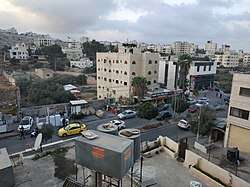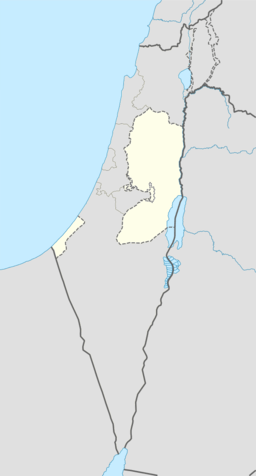Dheisheh
Dheisheh Refugee Camp (Arabic: مخيم الدهيشة) is a Palestinian refugee camp located just south of Bethlehem in the West Bank. Dheisheh was established in 1949 on 0.31 square kilometers of land leased from the Jordanian government.[1] The camp was established as a temporary refuge for 3,400 Palestinians from 45 villages west of Jerusalem and Hebron who fled during the 1948 Arab-Israeli War.
Dheisheh Camp | |
|---|---|
| Arabic transcription(s) | |
| • Arabic | مخيم الدهيشه |
| • Latin | ad Duheisha Camp (official) Dheishe Camp (unofficial) |
 Dheisheh Camp, 2018 | |
 Dheisheh Camp Location of Dheisheh Camp within Palestine | |
| Coordinates: 31°41′38.47″N 35°11′02.96″E | |
| State | State of Palestine |
| Governorate | Bethlehem |
| Government | |
| • Type | Refugee Camp (from 1949) |
| Area (approximate) | |
| • Total | 1,000 dunams (1 km2 or 0.4 sq mi) |
| Population (2008) | |
| • Total | 13,017 |
| • Density | 13,000/km2 (34,000/sq mi) |
Six decades of natural population growth have expanded the camp's dimensions into an area between 1 and 1.5 square kilometers. The exact dimensions are subject to periodic debate between residents, UNRWA and the Palestinian Authority. The latter two are required to provide services to residents, depending on their resident status within the camp.
Although initially living in tents, the residents have since constructed homes. Many streets are now paved, while still remaining very narrow. According to UNRWA, the entire camp is connected to the municipal water and electric systems of Bethlehem, yet 15% of the camp remains unconnected to the local public sewage system. These homes make use of communal percolation pits.[1]
Name
There are several alternative spellings of Dheisheh, making use of the Latin alphabet. An incomplete list of possible spellings includes "Deheishe", "Deheisheh", "Duheisha", "Dheisha", and "Dhaisha".
While "Dheisheh" is the spelling UNRWA uses,[2] the Palestinian Authority uses "ad Duheisha" in its documentation.[3][4]
There is little consensus among news agencies as to the proper spelling. While Al Jazeera English makes use of the "Dheisheh" spelling, the Palestinian news agency Ma'an has used the alternative spelling "Duheisha.".[5][6]
History
The people who gathered in Dheisheh originated from more than 45 villages west of Jerusalem and Hebron. Dheisheh is one of the refugee camps that was created as a temporary humanitarian solution to the problem of accommodating those expelled Palestinians. Towards the end of the 1950s the UNRWA started to build very simple living units: A single room of 10 square metres, 10 cm thick and 2.45 m high walls, a steel roof and a floor made of rough concrete. Refugees began to build their own houses so as not to live in the UNRWA's shacks any longer.
Since the Six-Day War in 1967, Dheisheh has been under Israeli occupation. During the years between Israeli occupation in 1967 and the camp coming under Palestinian Authority jurisdiction in 1995, Dheisheh was under curfew an average of 3.5 days a month, at one point lasting for 84 consecutive days. Throughout the First Intifada, a six-metre high barbed wire fence was installed around the camp, and thirteen of the camp's fourteen entrances were barricaded.[7]
On 23 February 2015, during an operation to arrest a resident of the camp, Israeli soldiers shot dead a 19-year-old man.[8]
Majid Faraj, the Palestinian Authority's chief of General Intelligence since 2009, was born in Deheisha Camp in 1962. He is a long time member of Fatah. He first experienced an Israeli prison at the age of 15 and has spent a total of six years in Israeli custody. His father was shot dead by the IDF in April 2002 during Operation Defensive Shield.[9]
Population
The population in the 1967 census conducted by the Israeli authorities was 4,149.[10]
Current population figures for Dheisheh are subject to disagreement between the respective census studies of the Palestinian National Authority and UNRWA. According to the Palestinian Central Bureau of Statistics, the camp was estimated to have population of 9,399 in mid-year 2006, following natural population growths from 8,829 persons in 2004 and 9,114 persons in 2005.[11] In January 2009, the Population, Housing, and Establishment Census 2007, undertaken by the same Palestinian Central Bureau of Statistics, on behalf of the Palestinian National Authority, reported the following statistics for the year 2007:[3]
| Demographic type | Total |
|---|---|
| No. of total persons | 8,736 |
| No. of females | 4,310 |
| No. of males | 4,426 |
| No. of housing units | 1,905 |
| No. of buildings | 1,170 |
| No. of households | 1,698 |
| Average size of household: | 5.1 |
Of note is the absence of approximately 700 persons from the estimated 2006 figure compared to the 2007 reported figure. Also, the 2007 reported figure is less than the initial figured reported by the Palestinian Central Bureau of Statistics for 2004.
UNRWA reported the following statistical figures for Dheisheh, as of 30 June 2008:[12]
| Demographic type | Total |
|---|---|
| No. of total persons | 13,017 |
| No. of families | 2,838 |
| No. of infants | 129 |
The discrepancy regarding the camp's population is influenced by several issues, most significant of which are the disagreements over the accepted dimensions of the camp and the status of unregistered residents. Residents of the camp are not taxed on their properties within the camp, and this results in disagreements as the camp community's population and geographical size continue to grow. The tax policy regarding the camp has resulted in the immigration of Palestinians who are not registered refugees with UNRWA. Accurate figures for these immigrants is non available.
Additionally, registration with UNRWA is voluntary and thus can not be expected to account for all eligible refugees living within the camp.
Based on the UNRWA statistics, Dheisheh is the fourth largest refugee camp in the West Bank, behind Balata, Tulkarm, and Askar (in that order). Dheisheh is thus the largest camp outside of UNRWA's Nablus district.
By comparison, Dheisheh camp would be the sixth largest after Balata, Askar, Tulkarm, Jenin, and Qalandiya (in that order), based on the figures reported by the Palestinian Central Bureau of Statistics.
Local organizations

A number of local as well as international organizations offer humanitarian services within Dheisheh camp. Many of these organizations have a particular focus. A few of them are listed above.
The Karama Organization is a local organization aiming at providing leisure activities for children living in the camp.[13]
The Ibdaa Cultural Center has the aim of creating a positive atmosphere for children in the camp.
The Future Vision Society for the Development of the Abilities (AREEN) is another organization located in Dheishe camp. This non-profit organization seeks to provide a better future for the children and youth in the camp, especially for girls.[14]
References
| Wikimedia Commons has media related to Dheisheh. |
- Dheisheh refugee camp profile UNRWA
- Dheisheh Camp Profile UNRWA
- Population, Housing, and Establishment Census 2007 Census Final Results in the West Bank - Summary Archived December 10, 2010, at the Wayback Machine Palestinian Central Bureau of Statistics
- Projected Mid-Year Population for Bethlehem Governorate by Locality 2004- 2006 Archived 2008-06-16 at the Wayback Machine Palestinian Central Bureau of Statistics
- The perspective from the street Al Jazeera
- Witness: Israeli Forces Invade Bethlehem Ma'an News Agency
- Palestine & Palestinians. Beit Sahour: Alternative Tourism Group. September 2008. p. 207. ISBN 9950-319-01-3.
- Ha'aretz 24/2/2015
- Ha'aretz
- Perlmann, Joel (November 2011 – February 2012). "The 1967 Census of the West Bank and Gaza Strip: A Digitized Version" (PDF). Levy Economics Institute. Retrieved 24 June 2016.
- Projected Mid -Year Population for Bethlehem Governorate by Locality 2004- 2006 Archived 2008-06-16 at the Wayback Machine Palestinian Central Bureau of Statistics
- Total Registered Camp Population - Summary Palestinian Central Bureau of Statistics
- Karama Goals
- "Archived copy". Archived from the original on 2018-10-12. Retrieved 2019-11-27.CS1 maint: archived copy as title (link)
Further reading
- Grossman, D. 1988. ‘A man is like a stalk of wheat’ in The Yellow Wind, Pan Books Limited: Farrar Straus and Giroux
External links
- Karama Organization
- Ad Duheisha Camp (Fact Sheet), Applied Research Institute–Jerusalem, ARIJ
- Ad Duheisha Camp Profile, ARIJ
- Ad Daheisha Camp arial photo, ARIJ
- The priorities and needs for development in Ad Duheisha camp based on the community and local authorities’ assessment, ARIJ
- Dheisheh, articles from UNWRA
